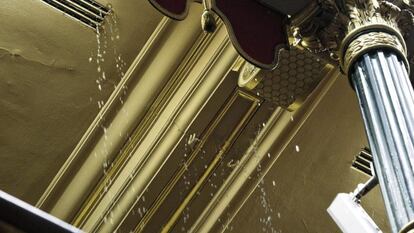Who covered the bullet holes in Congress?
Leaking roof led to discovery of disappearance of scars left behind by 1981 coup attempt
They were supposed to be there for eternity - a reminder as to how a fragile democracy once came under threat and left an entire country on edge. But now they are gone, and lawmakers in Congress want to know who ordered the sealing of five bullet holes that were put there by Civil Guard officers during the February 23, 1981 attempted coup.
Congressional speaker Jesús Posada is expected to present a report on Tuesday into the incident.
Nevertheless, lawmakers from Spain's political parties do not believe that there is a cover-up behind the covering up of the holes in the ceiling inside Congress.
But the inquiry, which was ordered by Posada, should determine when were they sealed and who ordered the job to be done.
Congressional sources believe that the main culprit could have been a lack of supervision when workers earlier this year began reforming the interior of the Congress building. But the same sources also rule out any conspiracy or "dark hand" involved in trying to erase history.
The sealed holes were discovered Wednesday morning when the roof of Congress began to leak, causing those present in the press pit to be evacuated.
Construction firm Dragados, which has been carrying out the work, denied that its ongoing project has anything to do with the leaky roof.
There have always been direct orders for workers carrying out refurbishment inside Congress not to touch the bullet holes.
"We are going to investigate what happened," said Posada. "If anyone wants those holes to be there forever, it is me." Posada was the civil governor in Huelva at the time of the attempted coup.
The night of February 23, 1981, Civil Guard Colonel Antonio Tejero and a group of officers barged into Congress and began shooting their weapons in the air. After a tense night, they surrendered the morning after.
Tu suscripción se está usando en otro dispositivo
¿Quieres añadir otro usuario a tu suscripción?
Si continúas leyendo en este dispositivo, no se podrá leer en el otro.
FlechaTu suscripción se está usando en otro dispositivo y solo puedes acceder a EL PAÍS desde un dispositivo a la vez.
Si quieres compartir tu cuenta, cambia tu suscripción a la modalidad Premium, así podrás añadir otro usuario. Cada uno accederá con su propia cuenta de email, lo que os permitirá personalizar vuestra experiencia en EL PAÍS.
¿Tienes una suscripción de empresa? Accede aquí para contratar más cuentas.
En el caso de no saber quién está usando tu cuenta, te recomendamos cambiar tu contraseña aquí.
Si decides continuar compartiendo tu cuenta, este mensaje se mostrará en tu dispositivo y en el de la otra persona que está usando tu cuenta de forma indefinida, afectando a tu experiencia de lectura. Puedes consultar aquí los términos y condiciones de la suscripción digital.
Últimas noticias
Most viewed
- Reinhard Genzel, Nobel laureate in physics: ‘One-minute videos will never give you the truth’
- Oona Chaplin: ‘I told James Cameron that I was living in a treehouse and starting a permaculture project with a friend’
- Pablo Escobar’s hippos: A serious environmental problem, 40 years on
- Why we lost the habit of sleeping in two segments and how that changed our sense of time
- Chevy Chase, the beloved comedian who was a monster off camera: ‘Not everyone hated him, just the people who’ve worked with him’










































